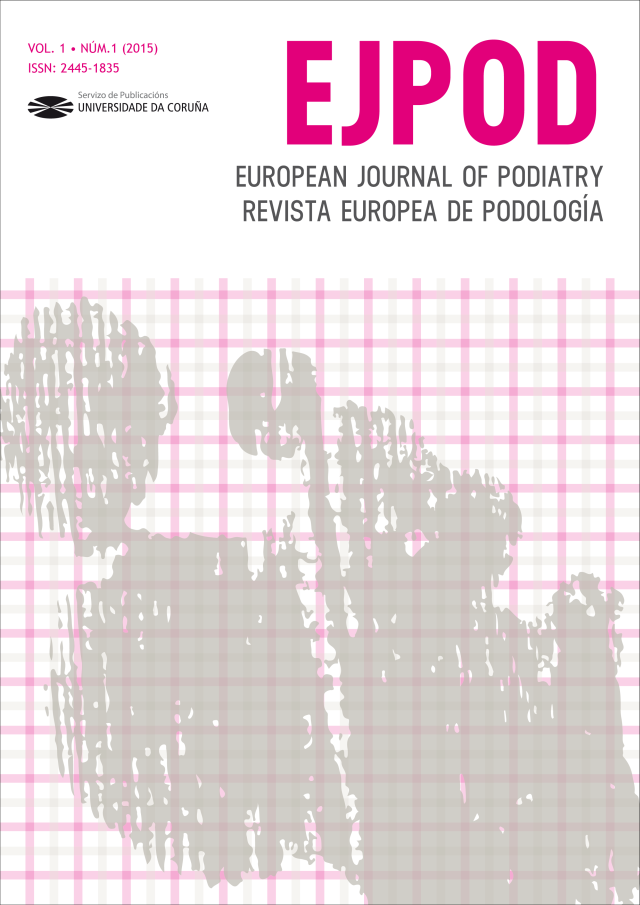Revisión y actualización bibliográfica del ligamento calcaneonavicular plantar
Contenido principal del artículo
DOI:
https://doi.org/10.17979/ejpod.2015.1.1.1468Resumen
Objetivos: El objetivo principal es revisar en la bibliografía descrita, si en el pie plano adquirido del adulto la insuficiencia del ligamento calcaneonavicular plantar es factor primario o, por el contrario, consecuencia de la insuficiencia tendinosa del tibial posterior.
Material y métodos: En la bibliografía consultada se analizan diversos atlas de anatomía y manuales de biomecánica del pie. Además, se han seleccionado 46 publicaciones científicas de interés en distintas bases de datos, estableciendo una serie de criterios de inclusión y de exclusión.
Resultados: Se trata de un ligamento que puede lesionarse de manera aislada o asociada a la disfunción del tendón tibial posterior. Como consecuencia, se desestabiliza la bóveda plantar, lo cual desencadena la flexión plantar del astrágalo y la alineación en eversión del calcáneo. El resultado clínico es la deformidad de pie plano adquirido en el adulto.
Discusión: Múltiples teorías se debaten sobre si la deformidad de pie plano adquirido procede o no de la insuficiencia del tendón tibial posterior, o bien es secundaria a la lesión de estructuras ligamentosas.
Conclusiones: El ligamento calcaneonavicular plantar o ligamento Spring es la principal estructura pasiva que mantiene la estabilidad estática del arco longitudinal medial del pie, la cual contribuye al sostén de la cabeza del astrágalo y proporciona equilibrio en la articulación talocalcaneonavicular. Si la lesión ligamentosa no se trata va a evolucionar hacia un pie plano adquirido en el adulto.
Palabras clave:
Fuente de financiación:
Detalles del artículo
Referencias
Jiménez-Catellanos J, Catalina-Herrera C, Carmona-Bono A. Lecciones de anatomía funcional y aplicada del aparato locomotor. Santander: Publicaciones de la Universidad de Sevilla; 2007.
Melão L, Canella C, Weber M, Negrão P. Ligaments of the transverse tarsal joint complex: MRI–anatomic correlation in cadavers. AJR Am J Roentgenol. 2009;193(3):662–71.
Davis WH, Sobel M, DiCarlo EF, Torzilli PA, Deng X, Geppert MJ, et al. Gross, histological, and microvascular anatomy and biomechanical testing of the spring ligament complex. Foot Ankle Int. 1996 ;17(2):95-102.
Deland JT. The adult acquired flatfoot and spring ligament complex. Pathology and implications for treatment. Foot Ankle Clin. 2001;6(1):129–35.
Taniguchi A, Tanaka Y, Takakura Y, Kadono K, Maeda M, Yamamoto H. Anatomy of the spring ligament. J Bone Joint Surg Am. 2003;85(11):2174–8.
Mengiardi B, Zanetti M, Schöttle PB, Vienne P, Bode B, Hodler J, et al. Spring ligament complex: MR imaging-anatomic correlation and findings in asymptomatic subjects. Radiology. 2005;237(1):242–9.
Sarrafian SK. Anatomy of the foot and ankle: descriptive, topographic, functional. Philadelphia: Lippincott Williams & Wilkins; 2011:157-75.
Kapandji IA. Cuadernos de fisiología articular: miembro inferior. Barcelona: Masson; 1984.
Resnick D, Kang HS, Pretterklieber ML. Internal derangements of joints. Philadelphia: Saunders; 2007.
Kohls-Gatzoulis J, Angel JC, Singh D, Haddad F, Livingstone J, Berry G. Tibialis posterior dysfunction: a common and treatable cause of adult acquired flatfoot. BMJ. 2004;329(7478):1328–33.
Yao L1, Gentili A, Cracchiolo A. MR imaging findings in spring ligament insufficiency. Skelet Radiol. 1999;28:245–50.
Toye LR, Helms C, Hoffman BD, Easley M, Nunley J. MRI of spring ligament tears. Am J Roentgenol. 2005;184(5):1475–80.
Kavanagh EC, Koulouris G, Gopez A, Zoga A, Raikin S, Morrison WB. MRI of rupture of the spring ligament complex with talo-cuboid impaction. Skeletal Radiol. 2007;36:555–8.
Vadell AM, Peratta M. Calcaneonavicular ligament: anatomy, diagnosis, and treatment. Foot Ankle Clin. 2012;17(3):437–48.
Vadell M, Araujo S. Vascularizacion del ligamento calcaneo-escafoideo. Tobillo y pie. 2010;2(2):28–36.
Moreno-de-la-Fuente J. Podología Física. Barcelona: Masson; 2006.
Tryfonidis M, Jackson W, Mansour R, Cooke PH, Teh J, Ostlere S, et al. Acquired adult flat foot due to isolated plantar calcaneonavicular (spring) ligament insufficiency with a normal tibialis posterior tendon. Foot Ankle Surg. 2008;14(2):89–95.
Ribbans WJ, Garde A. Tibialis Posterior Tendon and Deltoid and Spring Ligament Injuries in the Elite Athlete. Foot Ankle Clin. 2013;18(2):255–91.
Herráiz-Hidalgo L, Carrascoso-Arranz J, Recio-Rodríguez M, Jiménez-de-la-Peña M, Cano-Alonso R, Álvarez-Moreno E, et al. Disfunción del tendón tibial posterior: ¿qué otras estructuras están implicadas en el desarrollo del pie plano adquirido del adulto? Radiología. 2014;56(3):247–56.
Hollinshead WH. Anatomy for surgeons. New York: Hoeber-Harper; 1954.
Borton DC, Saxby TS. Tear of the plantar calcaneonavicular (spring) ligament causing flatfoot. A case report. J Bone Joint Surg Br. 1997;79(4):641–3.
Dyal CM, Feder J, Deland JT, Thompson FM. Pes planus in patients with posterior tibial tendon insufficiency: asymptomatic versus symptomatic foot. Foot Ankle Int. 1997;18(2):85–8.
Chu IT, Myerson MS, Nyska M, Parks BG. Experimental flatfoot model: the contribution of dynamic loading. Foot Ankle Int. 2001;22(3):220–5.
Kirby KA. Foot and Lower Extremity Biomechanics II: Precision Intricast Newsletters. Payson (Arizona): Intricast Newsletters; 2002.
Deland JT, de Asla RJ, Sung I-H, Ernberg L, Potter HG. Posterior tibial tendon insufficiency: which ligaments are involved?. Foot Ankle Int.2005;26(6):427–35.
Núñez-Samper M, Llanos LF, Martín J, Gómez L. Análisis funcional y estadístico de la bóveda plantar. Chir Piede. 1984;8(147):218-221.
Viladot A. Lecciones básicas de biomecánica del aparato locomotor. Barcelona: Springer Science & Business Media; 2001.
Deland J, Annoczky S, Thompson FM. Adult acquired flatfoot deformity at the talonavicular joint reconstruction of the spring ligament in an in vitro model. Foot Ankle Int. 1992;13(6):327–32.
Deland JT. Posterior tibial tendon insufficiency: soft tissue reconstruction. Op Tech Orthop. 1992;2(3):157–61.
Lee W-C, Yi Y. Spring ligament reconstruction using the autogenous flexor hallucis longus tendon. Orthopedics. 2014;37(7):467–71.
Thordarson D, Schmotzer H, Chon J. Reconstruction with tenodesis in an adult flatfoot model. Journak Bone Join Surg. 1995;77(10):1557–64.
Choi K, Lee S, Otis JC, Deland JT. Anatomical reconstruction of the spring ligament using peroneus longus tendon graft. Foot Ankle Int. 2003;24(5):430–6.


